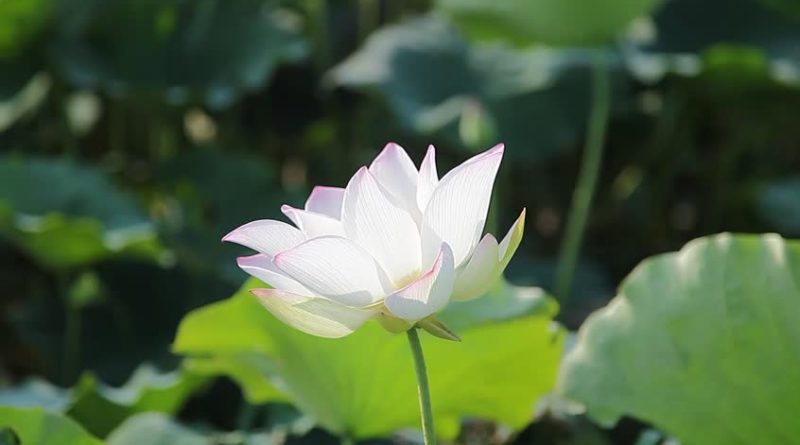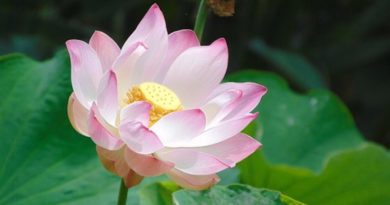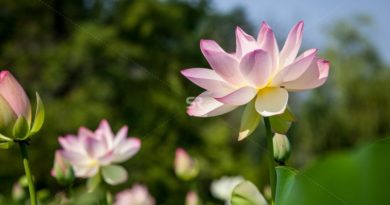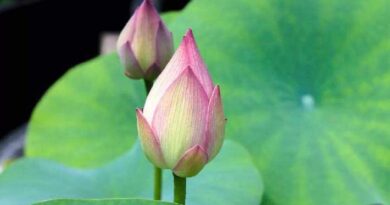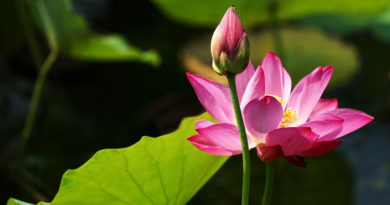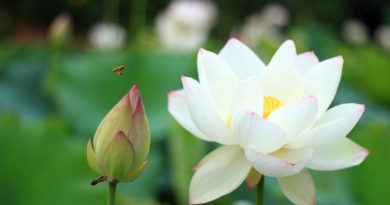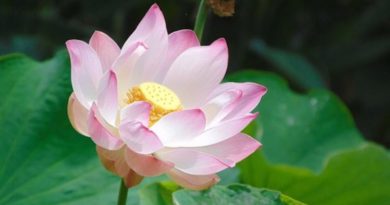PATIPADA – CHAPTER XIX: THE STORY OF VENERABLE ACHARN BROM
PATIPADA – CHAPTER XIX: THE STORY OF VENERABLE ACHARN BROM
We are near the end of this book of “Patipada” and it seems appropriate to write about an important Acariya who was a direct follower of Venerable Acharn Mun. This will be a memorial and a record to his excellence for those who have not seen his biography.
He was known as Venerable Acharn Brom (Brahma) and he used to live at Wat Barn Dong Yen, in the district of Nong Harn, Udorn Thani province, where he died a short while ago.
I read the short biography that was printed and distributed at the time of his cremation, but since then I have forgotten some of the details of it, for his cremation took place on 6th March 2514 BE (1971 CE). However it is probable that many people have not read that biography, so I shall repeat the story in brief to show what kind of Bhikkhu he was. The following account will not cover the period of his life when he was a lay person, but only those incidents which were important as well as the practices which he did as a Bhikkhu.
Before he was ordained, it seems that he announced to the world at large that he intended to renounce all his possessions and give everything away, both those which were material and those which had life, until there was nothing left. Then he and his wife would leave home and become ordained and follow the way of the Lord Buddha and the Savakas so as to reach their state in this life, for they no longer wanted to go on living through endless births and deaths in this world anymore. Those who wanted to help may come and receive these gifts and take them away freely to use as their own property without any recompense being expected in return. But they must come within a specified time limit, which he announced, and it seems that he allowed many days for giving away these things. Many poor and needy people came to him and received gifts, and this went on until all his possessions of all kinds had gone in a few days. He had many possessions, for he had been a wealthy and well established merchant in that region, who dealt in all sorts of goods. But for the whole of his married life he had no children and he just had his wife and various relatives, all of whom felt very happy with his renunciation of his possessions in order to become ordained. When he had given away everything, he and his wife separated and went their own ways. He went and became ordained as a Dhutanga Kammatthana Bhikkhu, after which he set out to reach Venerable Acharn Mun where he entrusted his life as a monk (Brahmacariya) to him. His wife went in a different direction to be ordained as a Nun with the intention of gaining freedom from samsara in accordance with her resolution, and they both lived the Good Life (Brahmacariya) for the remainder of their lives without becoming restless and concerned in the material world. Both of them should be a good example to others.
When Venerable Acharn Brom became ordained he could not at first do as he had intended. For he had to stay with Venerable Acharn Sara who trained him for some time until it was appropriate for him to leave. Then he went wandering in the district of Chiang Mai to find Venerable Acharn Mun who, at that time, was also living there. It is said that Venerable Acharn Brom wandered through all sorts of places until he crossed over into Burma and stayed in many places there. He was accompanied by Venerable Acharn Chob who had a very determined and courageous character who stuck by him whatever happened. They were like two flawless diamonds attached to the same ring as friends going the same way. This story was related to me by Venerable Acharn Brom, but I cannot remember all he said and I can only recall what I have written. I also apologise for any errors which I may make.
Venerable Acharn Brom had many strange and wonderful experiences associated with the practices which he did, both inwardly and externally, while he was in Thailand and abroad as well; but I’m afraid we must leave them and pass on. Hearing him tell his story made me feel so sorry for his plight in some parts of it, spellbound with excitement in other parts and full of admiration for his ability to fight against hardship, and also for what he experienced in his self-development. In addition, the way in which he walked right through thick jungle in various places, where in those days there were no villages or people was quite remarkable. At such times he had to put up with great hardships and privations, for he was rarely in a place where he had enough to provide sufficient for the body and ease of mind. He said that some days they would come across a village and get enough food on pindapata to keep them going. But on other days they had to go without and put up with feelings of hunger and weakness and spend the nights in the hills and forests when they had lost their way. He said that it was especially difficult when they were wandering in Burma, because the way they went there was nothing but hills and jungle full of animals and cats (tigers, leopards, etc.) of all sorts. Sometimes they just had to trust their lives to fate when the suffering and hardship was more than they could bear to go on facing for another day. When he got to that point it seemed as if everything within him came to the end of its tether all at once. His breath seemed as if it would no longer go on due to all the many and varied circumstances oppressing and tormenting his body and mind. But afterwards he managed to put up with each event as it happened as each hour and day passed by.
His citta had been developing steadily and he had confidence in himself when he finally reached Venerable Acharn Mun where he was taught and trained continuously from then on. Some years, Venerable Acharn Mun kindly helped him by letting him spend the vassa period together with him. At other times he used to come and go frequently — in other words, he would go out wandering to develop himself in various places wherever he felt like going. Then when any problem arose in his heart he would return for further teaching and training from Venerable Acharn, which took place from time to time. He spent many years training with Venerable Acharn Mun while he was in Chiang Mai province, and when Venerable Acharn returned to Sakon Nakhon province, he also went with him.
This Acariya had a very earnest and serious character and he was also very determined and resolute, as may be seen by the way he disposed of all his wealth and valuables and then became ordained in a really true way. But as to the results of the practice, which he gained in the form of a refuge for his heart, we may say briefly that he gained abundant “wealth” of the most wonderful and priceless kind on a remote hill in the province of Chiang Mai where he was living with the hill tribes. This is what he told me, unless my memory is faulty; but I cannot remember the names of the village, the hill, or the district where he gained freedom and finally got rid of the burden of the round of birth and death from his heart. After Venerable Acharn Mun had returned to stay in the province of Sakon Nakhon for several years, Venerable Acharn Brom followed him and spent the vassa at Wat Suddhavasa in Sakol Nakhon province. This was about the year 2486 of the Buddhist era (CE 1943). After this he returned and built a Wat in his home village, Ban Dong Keng, in the district of Nong Han in the province of Udorn Thani. This was where he came from and this is where he was cremated, as has been already related.
On the day of his cremation the place was full of Buddhists who came to share in the merit of the occasion. They came from far and near as well as many from Bangkok who had sacrificed their time to come. Many also came from Chiang Mai despite the time and trouble it took to get there. But in fact all of those who went to his funeral thought nothing of the difficulty and what it cost them, for their aim was just to make the occasion to be a fitting tribute to this Acariya. So it turned out that the Wat where they held his funeral, which normally seemed so spacious and open to everyone, was not big enough and became cramped and congested because of the large number of people, both the lay people as well as the Bhikkhus and Samaneras who came crowding in on that occasion. But even so, they were not boisterous or turbulent, because each of them had come with pure intentions and faithful hearts, free from ulterior motives which may have been a danger both to the occasion and to the people who had gone there.
On the night of this occasion, the organisers in the Wat had arranged for the teaching of Kammatthana to be broadcast to the people there for the whole night after the cremation. For this they had invited several competent Kammatthana Acariyas to give a series of talks. Some of them were general talks about Dhamma, some were about samadhi–Dhamma, and some were about pañña–Dhamma. But the subjects changed about so that some would be of value to those who were ordained and who followed the Dhutanga Kammatthana tradition, for generally speaking they rarely had any chance to hear such talks. Some would be of value for those white robed followers (Upasaka and Upasika) who were interested in the practice of Dhamma and some for the general run of lay people.
The actual cremation took place at about 10 p.m. on the night of 6th March 2514 BE (CE 1971). At the time of his cremation, the crowd of Bhikkhus, Samaneras and lay people who had come to pay their respects with sorrow, was very large. All of them were very calm and peaceful, which was a delight to see, and it seemed almost as if they were all recalling and contemplating the virtues and the refined excellence of Venerable Acharn Brom who had done the practice with such resolute courage and sacrificed everything without any regrets or longing. In addition, he had bestowed his enlightening Dhamma on all his followers, both those who were ordained and lay followers, and both men and women in large numbers. Now he had gone from them, having submitted to the law of impermanence (aniccam) which none of them could halt or resist even for a moment however much they respected, revered and loved him. Some of those who had never seen or met him may have tended to think more about the law of aniccam, which is Dhamma that teaches the world and oneself, rather than thinking of his Dhamma virtue.
When they had actually cremated his body, there were only the official organisers in the vicinity of the crematorium, who attended to his body. Nobody else was allowed to come in and interfere. This may have been because the previous frequent announcements had warned off the crowd — or may be it was due to the etiquette of those Bhikkhus who saw danger and value at that time. But it is not easy to resolve this speculation.
His Bones Turned into Relics in a Very Short Time
Many of those who came to Venerable Acharn Brom’s cremation were given very small bits of his cremated bone as a reminder and as a form of their Puja, so they went out to many places. Therefore it was not possible to keep track of them to know if any of them had changed their nature or not. But not long afterwards, a Bhikkhu who had been given some of the bone, brought it and showed it to us here in this Wat. This bone had already turned into two relics of Venerable Acharn Brom.
A bit later I saw in the “Sri Sapadah” magazine, that some of their share of bone from his cremation had also turned into relics, while other bits in the same container had not changed. One could not help feeling full of wonder at his Dhamma virtue, for this was a sure sign that he had fully attained the essence of Dhamma. This had been the assumption of those who practise the way for a long time already, but they had never said so openly in the way that people in the world do so. Because this was a matter of Dhamma, in which those who practise Dhamma should be self-controlled and careful, to keep within the bounds of what is right and proper.
Gaining Freedom From Dukkha
Venerable Acharn Brom told me in 2486 BE (1943 CE), that he had gained freedom entirely, from the thick jungle of kilesa and the great mass of discontent and suffering (dukkha), and that he had done this while staying in the province of Chiang Mai, but it is uncertain just when this actually happened. Afterwards he returned to the province of Sakon Nakhon, therefore in short, this means that from 2485 BE, when he went to spend the vassa in Wat Suddhavasa in Sakon Nakhon until he died in 2513 BE is 28 — 29 years. This is enough to show that from the day that his citta gained freedom and ruled over the khandhas with a pure heart, until the last day of his life was quite a long time. Therefore it is reasonably to be expected that his bone remains should become relics very quickly — in less than a year.
In the province of Chiang Mai, it is known that three monks became Arahant there in the present age. They are, firstly Venerable Acharn Mun, secondly Venerable Acharn Brom and thirdly Venerable Acharn … who is still alive; the latter two being followers of Venerable Acharn Mun. As for other provinces in Thailand, those in the Northeast (Isan), such as Sakon Nakhon, have also had their share of remarkable Bhikkhus who have become “pure in Dhamma”, no less than Chiang Mai. But they are not well known, because they are not people who talk about these things nor do they advertise themselves and they are only known amongst themselves and those who practise the way.
The places referred to in the last paragraph refer to the forests and hills of the respective districts, which is where those who practise the way go to stay, to practise and to attain the path and fruition as they had intended to. But they do so quietly, without anyone knowing about it. So if some of their stories are not written down here as evidence that it can be done now, the Dhamma of Buddhism will appear to be mere talk — whereas its true nature is not visible and apparent. Therefore I decided to jump into the middle of a bag of thorns and write down some of these stories as objectively as possible, although I’m afraid that I shall not be free of some sharp criticism that will come from those who disagree and disbelieve some aspects of these stories, as has already happened to some extent.
What has been written here is based: Firstly on a firm faith in the skill and ability of those who practise the way and who have managed to attain the basic ground of citta and Dhamma which is firm and unshakeable; and who also have a full and unwavering confidence in themselves. Secondly, in the way they speak out, proclaiming the “Rightly Taught (Svakkhata) Dhamma” with complete confidence and certainty in it. For this is what the Lord Buddha bequeathed to us, saying that it will be this “Rightly Taught Dhamma” that lasts and remains unaltered by any of the popularly accepted conventions which are so artful and deceptive and become part and parcel of the person who takes them up and relies upon them. But they give him no sense of confidence that he will be able to go on breathing freely in the future. Thirdly, in the way they speak about the field of practice (patipatti) and the attainments (pativedha) that come from it. For this is how they show up the results of their practice whether great or small — showing how this way is not worthless, nor is it a waste of one’s time and effort which gives no results in response to all the weariness and difficulty involved in doing the practice.
All the Acariyas that have been mentioned up to this point are fully possessed of the Path (Magga) of practice, which has sila, samadhi and pañña, fully developed, and they are beyond all reasonable criticism. They are the Acariyas who should attain the fruit of vimutti — freedom — of the kind that accords with the causes and results which come following the undisputed truth of the Dhamma teaching. As for those who still have faith that Dhamma exists as Dhamma, they are the Acariyas who should reach the Path and the Fruition, with their practice following the policy of Dhamma and they can live in the field of “Puññakkheta” — the field of merit and righteousness — without any suspicions of doubt or uncertainty.
In writing about these Acariyas, I feel no doubts or reservations — nor is it likely to vex the hearts of those who read about them. On the other hand, we must accept that anybody who thinks in any different way from the above, has the power and the right to do so without consulting or getting permission from anyone else. For it is said in the Dhamma that:
“Beings are the owners of their own kamma, and the results of their kamma belong to them alone.”
Other people therefore should not go and interfere, and try to take on a share of the responsibility, which would be contrary to this aspect of the law of kamma that has been proclaimed and taught with complete certainty since ages past.
Venerable Acharn Brom once told me about how timid and incomplete he was, soon after he had been ordained, and also about a time when he went to stay in the hills of Chiang Mai province. Not long after his ordination and before he had even been one vassa period in the robe (i.e., less than a year), he went out wandering in quiet and peaceful places in the hills in the district of Na Kae of Nakhon Phanom Province. On his return trip, he followed the track which went straight from Na Kae District to Sakon Nakhon Province. In those days there was no road, and even the cart track or footpath was heavily overgrown and was hardly visible in places. Because along this track, about four kilometres from the provincial town of Na Kae there was a large expanse of thick jungle, its length running along by a range of mountains, full of all sorts of animals like tigers and other cats. The type of place that timid people would call very frightening and would never want to go to.
By chance, it happened that Venerable Acharn Brom reached this forest in the evening, just as it was getting dark. He had no candles left to use in his lantern and if he had decided to go on regardless, he was afraid he would lose his way. For nobody lived there and there were no houses or villages anywhere near, and even the path was overgrown and blocked by trees and forest in places. It was quite different from the same place nowadays where there are villages and people everywhere — and even the thick forest has gone without a trace, to be replaced by fields, houses and plantations.
So Acharn Brom decided that he would have to spend the night there. He went off a little way to one side of the path and hung his umbrella tent (klod) from the branch of a tree. Then groping about in the twilight, he gathered up some dry leaves from around the place, enough to act as bedding on the bare ground so that he could lie down. From then on he rested and did his meditation practice. About 9 p.m., which was during the time he was sitting in samadhi practice with a degree of apprehension and mistrust of his surroundings in various ways, it happened that a deer came softly and quietly into the area where he was staying, quite unaware of his presence. As soon as the deer which is a timid and cautious animal, emerged from the surrounding forest and came face to face with the Acharn’s umbrella tent and mosquito net which hung from it, forming a complete enclosure around him, it let out a single loud cry, “Kek!” just once, while it jumped back into the forest, hitting its head against trees and branches, and crashing through the undergrowth with a lot of noise. The Venerable Acariya also was so startled and frightened so that without thinking he shouted out “Euk-aak,” and the deer, hearing the sound of a person, was even more frightened and ran as hard as it could go deep into the forest.
As soon as the Acharn regained his composure and mindfulness, he thought with shame how incompetent he had been, and he could not help laughing at himself. For as he said:
“There I was, a true Bhikkhu, having been ordained after renouncing and disposing of all my possessions and I was prepared to accept death wherever it may come to me with a ready heart absorbed in Dhamma, so how was it that a deer, a most mild and ordinary forest animal should frighten me so much? It was not like a tiger, a boar, a ghost or a demon which may reasonably instil fear into people; and in fact it ran away in blind panic, crying out in genuine fear of me, having been startled and lost all self-control. But I am a man and a full Kammatthana Bhikkhu, yet I was so startled and afraid of it that I could hardly breathe. This is really a worthless state, having no mindfulness to restrain the heart so that it gave in to a low and inferior state of the kind that makes an unseemly display of self and our religion for that deer to hear quite clearly so that it ran crashing into the forest without thought of any other dangers. If that deer had been clever enough to realise that Bhikkhus who truly believe in kamma and who have renounced everything are not timid and easily frightened like this Kammatthana Bhikkhu who is displaying such fear that he has lost all self-control, it would probably see the funny side of it and go away roaring with laughter at me for sure, and I would be so embarrassed, having no face left in my standing as a Bhikkhu at all. But fortunately, it was just an animal concerned for its life, which was passing by, and such a consideration never arose, for it has no interest in whether this person was a madman or a good normal person.”
Venerable Acharn Brom said that once when he was living in the hills of Chiang Mai province an event took place of a more normal kind which did not make a special impression on him. It was about 5 o’clock in the afternoon and he had gone to bathe in a deep stream at the foot of the hill. He never expected anything unusual to happen then, because he had been going to this stream every afternoon. But this day, he was walking along the stream which is in a narrow gorge with steep banks, and when he had about reached the place he was making for after going along a part of the stream where it was narrow and winding, he turned a corner and suddenly reached that place at the very same time as a large bear coming in the opposite direction. They both saw each other at the same time and there was no easy escape route. The large bear was very startled and frightened and leapt up the steep bank and slipped down. Again it leapt up and slipped down and went on doing this four or five times without success before it realised that it could not escape that way, so it turned round and ran back the way it came.
As for the Venerable Acharn, one could not say that he was afraid, nor that he was not afraid, because both of them were so startled and bewildered by their encounter that neither had any mindfulness left to give them any self-control. This gave a clear indication in this incident of how both of them at that moment were overwhelmed by a fear of death. For the bear jumped up and tried to climb the bank in a frenzy of fear, while the Venerable Acharn just stood there stamping his feet, so the ground round there became all disturbed and muddy, as if the clay had been mixed up for making bricks or pottery. Meanwhile he had been making noises, saying “Ow! Ow…,” continuously without being aware of what he was doing. After this big and amicable bear which arouses one’s sympathy, had gone away, Venerable Acharn said that he walked straight back to where he was staying, while seeing the funny side of this incident and feeling compassion for this bear which was so knowing and so good. What he had not realised was that he was dripping with sweat as though he was about to die during this incident. In fact he was soaked and more wet than if he had bathed normally.
Venerable Acharn said that he had not continued with his original purpose of having a bath and had left the place straight away because he thought it was likely that after this bear had jumped about and ran away, it would be exhausted and may return to lie down on a submerged rock and soak in the water to relax. For, he was afraid that to meet up with it once again might bring a response quite different from the first time. The next day he again went to bathe in the same place, and when he got to the point where he first saw the bear face to face, he took the opportunity to examine the characteristics of the fear of death, which is common to all beings in the world. Having looked at it well, he said that he couldn’t help laughing out loud, because the marks made by the bear in trying to climb that bank and his own footprints where he had been stamping up and down looked more like the work of ten bears and ten Kammatthana Bhikkhus playing at sports. The area was so messed about and muddy and hardly any of the original ground was visible. Looking at it made him feel horrified as well as compassion for the bear and this happened every day, for the place acted as a reminder, when he went there to have his daily bathe. He would see his own footprints as well as those of the bear displaying the fear of death every day until he left that district.
Normally when a bear comes across a person unexpectedly, it will jump on him and claw and bite him and injure him to put him out of action first, then it will run away. It is preferable to meet a tiger rather than a bear, for the bear will attack first before escaping, whereas the tiger will only attack if it has been shot and injured, and then it is more fierce and dangerous than a bear. Therefore, the Venerable Acharn could not help being appalled by this incident even though it turned out to be harmless.
I feel that making the effort to write about the practice of Kammatthana following the way of Venerable Acharn Mun is a heavy responsibility. Although the burden is not so heavy as it was in writing “The Biography of Venerable Acharn Mun”, and I have some room to breathe here. But even though the burden of writing is heavy I have constantly tried to put whatever ability I have into it. As to whether all of you who have read and understood it up to this point will agree with it and see it as right or wrong and good or bad in any way is uncertain. But I must accept whatever criticism is made without recourse to making any correction, because in both cases (the Biography and this book), I have already put everything I can into them with whatever ability I have and I cannot do any more.
The number of Bhikkhus who followed, and still follow the lineage of Venerable Acharn Mun are many. They come from the early period, the middle, and the final years of his Teaching. As well as those who followed his disciples and who received the same teaching and practice which was handed down to them, right down to the present day. But in writing this book, their names have been withheld — as was said previously — in those cases where their ways of practice have been described. This is because it would make difficulties for myself and for those whose stories have been disclosed. This has already happened in the case of those whose names were disclosed in “The Biography of Venerable Acharn Mun”, for there seemed to be some objections relating to those whose names were mentioned in connection with the events that happened to them. Some of them also said that the writer should do the same with himself! So I must accept their viewpoint and I have not gone against their wishes in writing this book. Their names have been withheld and only their story told — which involves the way they did the practice.
The way of practice of each Bhikkhu will be hard and acetic or easy in the various aspects of Dhamma accordingly, such as the hardship involved in not lying down, or taking little food. Those who work with urgency and consistently at such practices until they see the results of them quite clearly apparent, arising steadily, will not feebly give up and slide backwards. In fact, the results that are attained from all such methods are similar and consist of a state of calm and happiness in the heart — the citta — as well as the arousing of mindfulness and wisdom in successive stages, for these are the Dhammas which help and support the citta to reach the final goal in all cases. Therefore it is important in the practising of Dhamma that the aspect of Dhamma, which means the preliminary repetition (parikamma word) that is used in meditation practice to control and guide the citta, should be one which suits the individual’s tendencies of character at each stage and level.
But it is not really correct for the Acariya who trains and teaches his followers, to decide and determine this on his own, and then to reveal this one aspect of Dhamma to all his many followers for them to practise in their meditation, without having taken into account the characters of his followers and their different temperaments. For this one method will arouse obstacles in those whose characteristics are not suited to this aspect of Dhamma, and they will not get the results which they should get.
The Acariya just needs to be there to point out the way to go, after having explained many aspects and paths of Dhamma, so that those who have come to learn and train themselves may choose one of them and then go and practise it until they get results, after which they should go and tell the Acariya about it. Then if in what they tell the Acariya there is anything that he sees which needs correcting or developing in any way, he will point it out as it may be in each individual.
But it is not for the Acariya to determine on his own what methods of Dhamma training his followers should do. The only exceptions to this are those rare Acariyas who have the greatest skill in the practice of Dhamma and the faculty of knowing “Paracittavijja” — which is the ability to know the characteristic tendencies (upanissaya) and the present state of the citta of other people, as well as being skilled in methods of teaching them with quick wit and clever ways. This makes them able to decide what is the right parikamma for others to use, by virtue of what they have found in their own experience to be right. But nowadays, where can one find anybody who is so able and skilled in Dhamma as this? It is far more difficult to find such a person than to find a perfect flawless diamond. It is even difficult enough to find someone who has practised the way until he has come to know the causes and results of each of the different kinds of kilesas which arise in his heart. Until he has been able to remove them in a way that is clearly evident to him, and then put what he has attained into teaching others in the right way with assured certainty.
To find such a Teacher is so difficult that it has almost reached the point where people say that the state of “wealth” in the Buddhist Religion is worthless and that one can no longer find any essence of truth (sara) in it, even though it is the system which has given a guarantee of the Path, Fruition and Nibbana since the Enlightenment of the Great and Original Teacher, and has upheld it right up to the present. When this is the case amongst those who are Buddhists, is it likely that any of them will have enough of the faculty of Paracittavijja — to know the characteristic tendencies and the present state of the citta of other people with confidence? Or with sufficient confidence and certainty to teach just one aspect or method of Dhamma, guaranteed by that within themselves, which gives these teachers complete assurance? And to do this, while at the same time steadily leading their many followers to gain those results which are a refuge for the heart, and to continue until they are able to penetrate into and reach the highest level of Dhamma without changing or altering that one method of Dhamma to adapt it to their changing level of citta and level of Dhamma (bhumi–citta — bhumi–Dhamma). And also without changing or adapting it to the changes that take place in the kilesas and asavas, which are more adaptable and changeable in the most intricate ways than the footprints of a herd of cows in a farmyard. In fact it is probable, that anyone teaching in this way does so to give himself power and authority in the status of an “Acariya”, to which he has raised himself, rather than because he has the quality of Dhamma in its practical application in his heart.
Therefore I feel the greatest misgivings and doubts about teaching by the use of a single method of Dhamma. For I am a Bhikkhu of the kind who has naturally and characteristically had to struggle and strive. So when those who are absorbed and intent on Dhamma ask me questions, I answer in the manner of — “one hand holding a snake and the other hand holding a fish”, so that those who want to train themselves can choose to take up whatever they feel is suitable according to their own disposition, so that it will not then go against their characteristic tendencies. If they grasp only one hand, so as to get the hand which holds the fish, it will be of some value to themselves and to others also. But if they grasp only the other so as to get the hand that holds the snake, they will be very harmful and dangerous to those who come to learn from them.
In other words, those who come to be trained by them are taught only one random aspect or way of Dhamma and that’s all, as though the Sasana only has that one way of teaching the world. Whereas, in fact, the Great Teacher and all the Savakas did not complete the task with only one aspect of Dhamma but with many different aspects. In addition, the Lord Buddha taught them and taught the world enough aspects of Dhamma to suit the ability of beings in the world. But this would seem to have been a very small proportion of what was available to his knowledge and skill in his basic capacity as the Lord Buddha — who was the supreme Teacher (Sasada) of the world.

